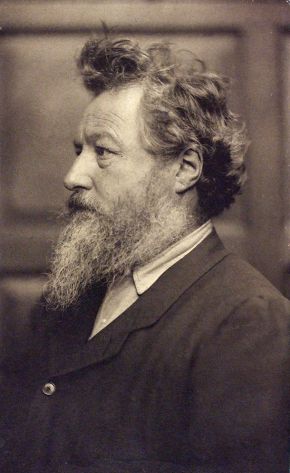The Arts and Crafts movement developed in the late 19th century.
This new style that designers soon adopted challenged the specific tastes of
the Victorian era, and were influenced by social reform thinkers ("The
Arts and Crafts Movement"). One of these thinkers was William Morris (Meggs, Purvis 177). In
this particular blog I will be focusing on Morris's path in context to his
artistic and designer abilities. William Morris is best known for his designs
that were on fabrics and wallpaper. He gave value to art by focusing on
hand-crafted artwork instead of factory-made. I chose William Morris as my
second blog reflection, because I believe that his artwork from the 1800's has
a strong Renaissance influence.

Above: Hollyer, Frederick. William Morris. 1884. Victoria and Albert Museum, London. Victoria and Albert Museum. Web. 1 February 2014.
The Arts and Craft movement involved many artists like William Morris, who
believed that the Industrial Revolution was destroying the trade of traditional
skill and moving toward machine only production ("William Morris: Father of
the Arts & Crafts Movement"). Morris had the idea that any hand
crafted goods were better quality than goods that were created by any type of
urban factory. When looking at many of Morris's designs they all have a strong
Gothic art style, but to also incorporate nature as much as possible. Morris
believed that "nature was the perfect example of God's design,"
("William Morris (1834-1896)"). When Morris creates his artwork, he
believed through his practice he was glorifying God ("William Morris
(1834-1896)").

Above: Morris, William. Trellis. 1862. ArtyFactory.com. Web. 1 February 2014.
'Trellis' was Morris's first wallpaper designs. As seen above, you can see
how not only is nature highly influenced, but there is a Renaissance style to
his artwork. It copies a lot of the illuminated manuscripts and tapestries that
were popular in that time period’s art. Today Morris's wallpaper designs are
still published in high quality, like 'African Marigold' or 'Tulip and Willow

Above: Morris, William. African Marigold. 1876. ArtyFactory.com. Web. 1 February 2014.

Above: Above: Morris, William. Tulip and Willow. 1873. ArtyFactory.com. Web. 1 February 2014.
Another influence William Morris had on the Arts and Crafts
Movement is Kelmscott Press. Morris's Kelmscott Press was founded in 1891, and continued
Morris's view on hand-crafted art ("William Morris (1834-1896)").
Kelmscott Press produced hand-printed books, which all had a Renaissance style.
Along with Kelmscott Press printing books, he also created three typefaces:
Golden, Chaucer, and Troy Troy

Above: William Morris. Typefaces. 1897. Web. 1 February 2014.

Above: Ludovicus Vicenrini. 1522. Web. 1 February 2014.
Overall, looking at William Morris style, I believe that he has
adopted not only the Renaissance style in fine arts, but also the lifestyle by emphasizing
hand-crafted artwork versus factory made. I believe that this is a relevant
argument in today's society when it comes to art, local stores, or anything
made in the USA
Reference:
Devroye, Luc. "Ludovico Vicentino degli Arrighi da Vicenza". McGill University. 2014. Web. 1 February 2014.
http://luc.devroye.org/fonts-32497.html
Jirousek, Charlotte. "The Arts and Crafts Movement." Art, Design, and Visual Thinking. 1995. Cornell University. Web. 1 February 2014.
http://char.txa.cornell.edu/art/decart/artcraft/artcraft.htm
Jones, Ralph. "William Morris: Father of the Arts and Crafts Movement". The Arts & Crafts Society. 1995. Web. 1 February 2014.
http://www.arts-crafts.com/archive/wmorris.shtml
Meggs, Philip and Alston Purvis. Meggs' History of Graphic Design. Hoboken: John Wiley & Sons. 2012. Print.
"William Morris (1834-1896)" Artsy Factory. 2014. Web. 1 February 2014. http://www.artyfactory.com/art_appreciation/graphic_designers/william_morris.html
No comments:
Post a Comment